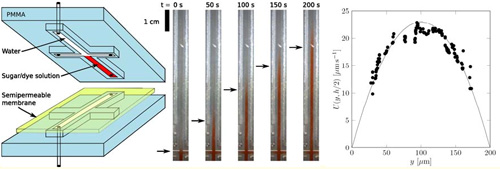Osmotically-driven Flows in Microchannels
Separated by a Semi-Permeable Membrane

Holbrook's group has studied osmotically-driven, transient flows in 200 mm wide and 50-200 mm deep micro-channels separated by a semipermeable membrane. These flows are generated by the influx of water from the lower channel, through the membrane, into the large sugar concentration placed in one end of the top channel. They have observed that the sugar front in the top channel travels with constant speed, and that this speed is proportional to the depth of the channel. They propose a theoretical model, which, in the limit of low axial flow resistance, predicts that the sugar front should travel with a constant velocity. The model also predicts an inverse relationship between the depth of the channel and the speed and a linear relation between the sugar concentration and the speed. A comparison of the theory and experiment with good agreement. Their research suggests that osmotic elements can act as pumps with no movable parts in lab-on-chip systems.
David A. Weitz (Physics & Applied Physics)
Cynthia M. Friend (SEAS)
N. Michele Holbrook (Harvard)
Jinkee Lee (Harvard),
Kaare Hartvig Jensen,
Thomas Bohr, and
Henrik Bruus (Technical University of Denmark)
Harvard MRSEC (DMR-0820484)
